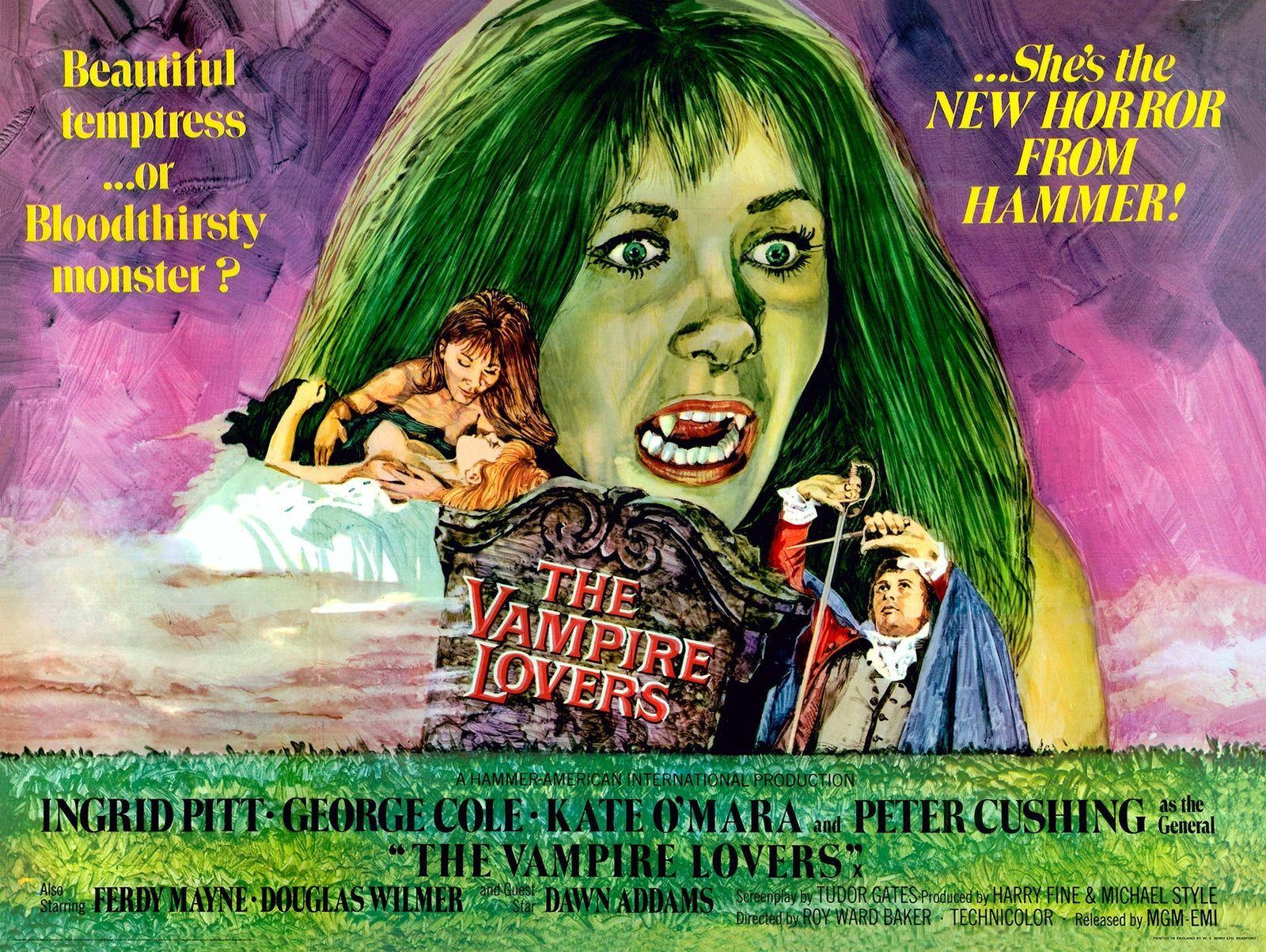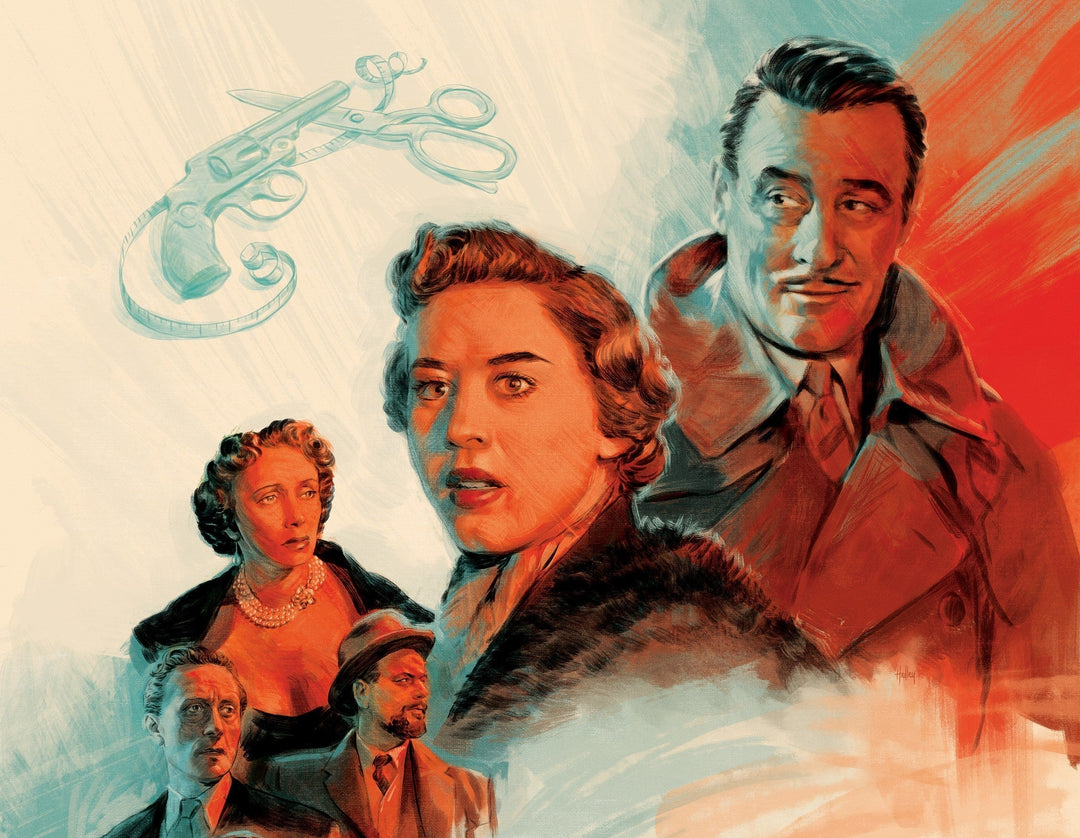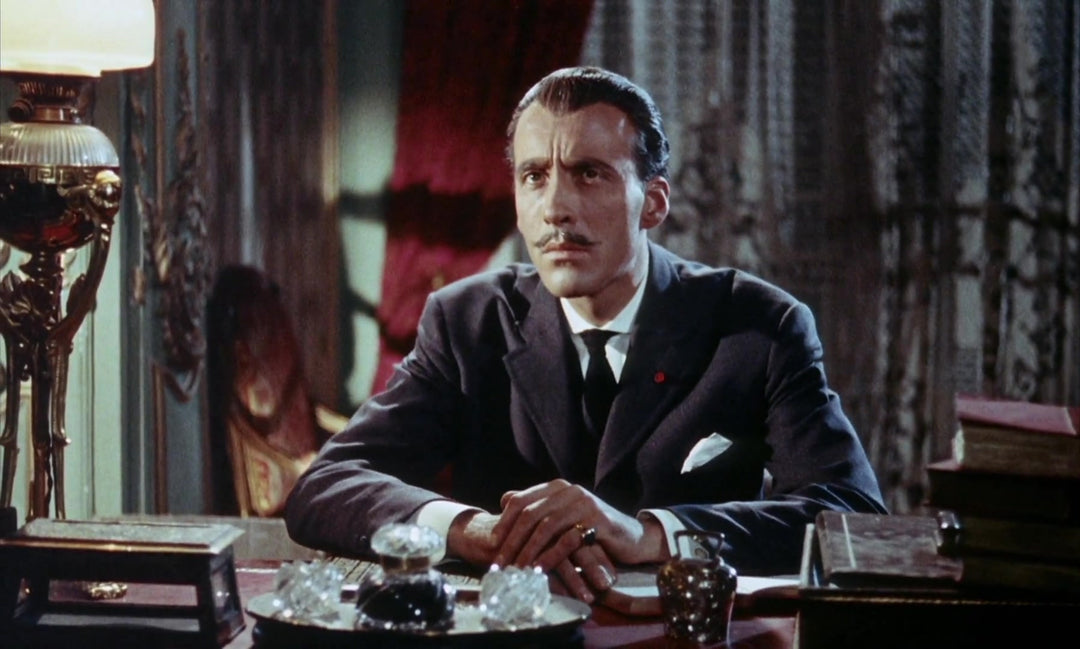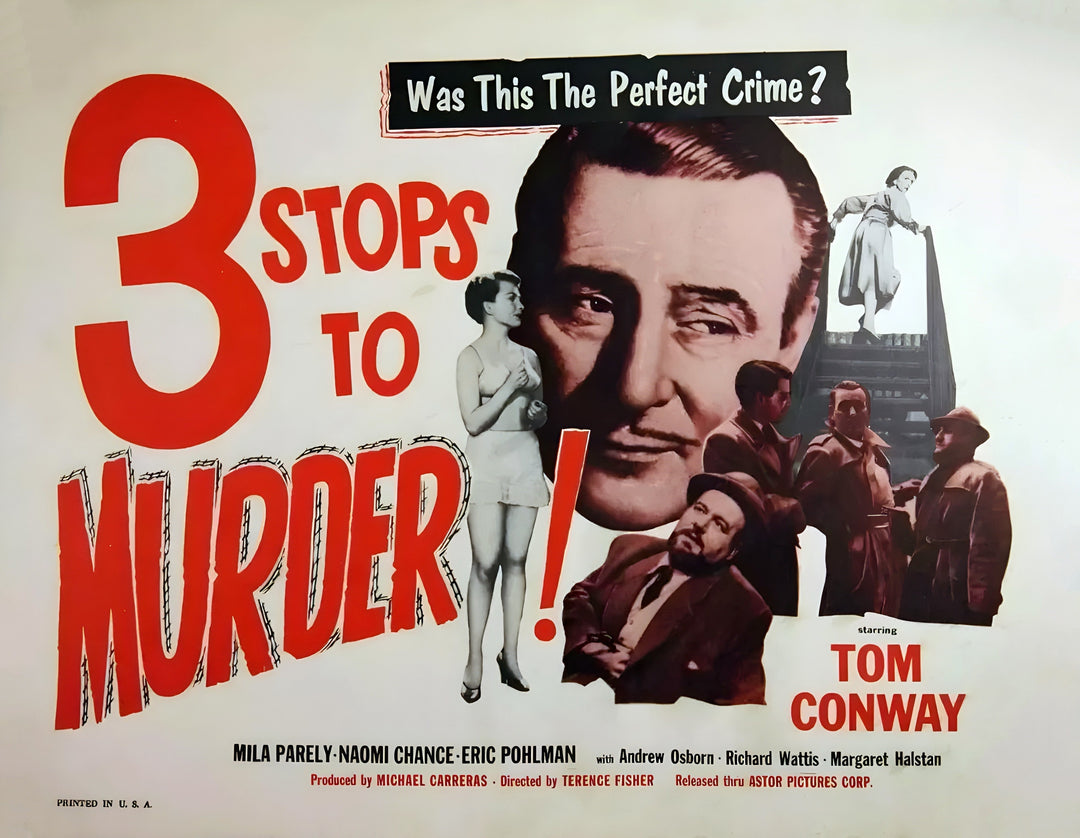The Vampire Lovers: Queer as (Undead) Folk

Camp classic? A trailblazer for queer horror? An exploitative money grab? Or, in the words of its star, Ingrid Pitt, just your everyday story ‘about a couple of nubile girls in a grand house in a hot Styrian summer with nothing to do but play with each other’?
The Vampire Lovers (1970) doesn’t defy simple categorisations. It’s far too arch for that. It embraces them all and lets you decide which are valid and which are as fake as Pitt’s famous fangs which refused to stay in place whilst shooting the movie. But 55 years after it first played in ABC cinemas across the UK, we sink our teeth into The Vampire Lovers and examine how it beat the censors, wowed the critics and became… well, whatever it became.
The Vampire Lovers (1970) is based on one of Joseph Sheridan Le Fanu’s most famous works, Carmilla, a novella initially serialised in 1871/72. Debuting a quarter of a century before Bram Stoker’s Dracula hit the shelves, it stands as one of the first published vampire tales, but although moderately successful, it wasn’t met with the immediate success that later greeted the Count.
It follows the story of Laura, a young woman befriended by the mysterious Carmilla who emerges as a secretive, commanding and at times beguiling figure. She’s also a vampire. Undead, but very much alive. Societal diktats ensured Le Fanu couldn’t be too explicit about the nature of the relationship the two central characters enjoyed, but Carmilla’s overtures are pretty overt. In one of Victorian literature’s most quotes passages, Laura tells the reader:
‘Sometimes after an hour of apathy, my strange and beautiful companion would take my hand and hold it with a fond pressure, renewed again and again; blushing softly, gazing in my face with languid and burning eyes, and breathing so fast that her dress rose and fell with the tumultuous respiration. It was like the ardour of a lover; it embarrassed me; it was hateful and yet overpowering; and with gloating eyes she drew me to her, and her hot lips travelled along my cheek in kisses; and she would whisper, almost in sobs, “You are mine, you shall be mine, and you and I are one for ever.”‘
As icebreakers go, Carmilla’s play is certainly more effective than a comment about the weather, and coming early in the narrative it helps establish her as one of the first and most important figures in the ‘lesbian vampire’ sub-genre.

An early illustration from Le Fanu’s Carmilla.
As is to be expected, the men within the novella turn against her, but not simply because of her murderous and supernatural aspects. As Clare Nee observed in The Haunt of Injustice: Exploring Homophobia in Vampire Literature, ‘Carmilla is demonized for her sexuality and involvement with the daughters of these men, she is hunted by the male alliance who seek vengeance and the restoration of their own power and control within the world…The notion of justice, however, is skewed by the homophobic undertones that haunt these individuals.’
This centrality of sexuality and its ramifications in Le Fanu’s tale were to have repercussions that the author couldn’t possibly have foreseen…

Ingrid Pitt (left) and Madeline Smith in a still for The Vampire Lovers.
Fast-forward 90-odd years after Carmilla’s publication. Movie producers Harry Fine and Michael Style approached writer Tudor Gates to adapt Le Fanu’s gothic novella for the big screen. Hammer exec James Carreras was pitched the idea and instantly loved it. Events then moved at a dizzying speed. In late November, 1969 a deal was inked between Hammer, Fine and Style, and shortly afterwards Carreras finalised financing through AIP. Gates delivered a draft script in December and as the 1960s vanished in a purple haze, The Vampire Lovers was suddenly in line to be Hammer’s first film of the 70s. Renowned director Roy Ward Baker (credited throughout his early career as simply Roy Baker) was brought onboard and pre-production was well underway before the new decade was rung in.
But even prior to the first day of filming, Hammer hit opposition to the nature of the eroticism featured in The Vampire Lovers. They sent Gates’s script to the British Board of Film Censors who found the character of Carmilla to be a flag as red as her favourite frock. The fact she was an supernatural killer wasn’t remotely a problem. The fact she wasn’t straight was.
The Board’s Secretary, John Trevelyan, warned Hammer that it would face obstacles getting the script, as written, to the screen. He informed the studio that he’d demanded significant cuts to The Killing of Sister George (1968) before it had been passed, due to its depiction of queer sexuality. And even after that censorship, the subsequent, shorter version had an X rating slapped on it for good measure. Trevelyan, talking about moments of intimacy shared between two consenting women in that film, went on record as declaring the BBFC was ‘not prepared as yet to accept lesbian sex to this point.’
It’s worth remembering these words to help contextualise the era. The 60s may be regarded by many as the dawn of a permissive society, but what that society permitted was still very much predicated on heteronormative posturing.

‘I do feel we’ll be such good friends…’ Ingrid Pitt (left) as Carmilla (aka Marcilla) and Pippa Steel as Laura.
Suffice to say Trevelyan didn’t think Hammer’s same-sex dynamics would survive the Board’s attentions. The urgency of the developing situation was heightened by the timings involved. Shooting had begun on The Vampire Lovers on January 19, 1970 and the BBFC’s feedback came later that month, followed by a ‘concerned’ memo from Trevelyan to Carreras on January 29th. And here’s where the centrality of sexuality in Le Fanu’s novella came to Hammer’s rescue. They argued its presence (indeed, its predominance) in the classic Victorian source material was enough ‘justification’ for its depiction in their adaptation. Somewhat bizarrely, the Board agreed and The Vampire Lovers was spared dilution into The Vampire Just-Good-Friends.
Trevelyan’s belief that a precedence in literature was enough to make a verboten scene acceptable feels bizarre. Why should a cinematic representation be considered too outrageous and unsuitable for modern audiences if it was wholly original, but perfectly acceptable if torn from the pages of a little-read book published almost 100 years earlier? The point is open to conjecture, but The Vampire Lovers was by no means the first production to be saved by this get-out-of-edit-suite card.
Back when the Hays Code held sway over what filmmakers could get away with, the ‘it’s in the novel!’ defence often proved effective. It’s the only reason, for example, that Rhett Butler’s notorious final line in Gone With The Wind (1939) wasn’t something along the lines of, ‘I’m not all that fussed, Scarlet,’ and could be, as Margaret Mitchell intended, ‘Frankly my dear, I don’t give a damn.’
With the BBFC hurdle duly cleared, shooting on The Vampire Lovers continued apace and the production wrapped on March 4, 1970.

Marketing material for The Vampire Lovers featuring Madeline Smith (left) and Ingrid Pitt.
It’s important to note, of course, that it was by no means the first queer horror movie Equally, it’s difficult to categorically award any film that designation. As Lucy Holmes pointed out in Queerness and Horror, ‘Horror and queerness have gone hand in hand since it’s origins… Unlike any other genre, horror invokes so many queer readings and an avid love from the LGBTQ+ community because of its metaphorical (and at times physical) rejection of the heterosexual status quo.’
Some observers have suggested that the distinction of ‘first queer horror film’ should go to the expressionist vampire silent, Nosferatu: A Symphony of Horror (1922).
In her feature, How Nosferatu Director F.W. Murnau Queered The Cinematic Vampire Forever, BJ Colangelo wrote, ‘Nosferatu is presented as the double of Hutter, representative of the gay desire that Hutter desperately tries to repress. Nosferatu is not subtle with his desires, frequently staring at Hutter for long periods of time, the black around his eyes darkened to emphasize his gaze.’ Colangelo also points out ‘how phallic he [Nosferatu] appears in just about every frame. He’s long, sleek, and rounded on top, frequently inserting himself into dark, thin doorways that only emphasize how much he looks like, well, you know.’
Yes. We know. Oh, we know.

A moment from Nosferatu featuring Max Schreck as Count Orlok, widely seen as an early version of Count Dracula.
The works of James Whale (an openly gay director who made no secret of his relationships at a time when such candour was rare) must also come into contention. As Savannah Wahlgren pointed out in Queer coding of American classic horror films, ‘In this sequel, [The Bride of Frankenstein – 1935]… There is something inherently queer about Frankenstein abandoning his new bride before they can consummate their marriage to go create a life with another man, and the original cut of the film expanded on this even more.’
Other early horror pictures where gay undertones could be considered overtones include Dracula’s Daughter (1936), Cat People (1942) and The Seventh Victim (1943).
It’s also been mooted that Hammer had already given us a clandestine gay relationship with The Curse of Frankenstein (1957). Writing for Fangoria, Samantha McLaren stated, ‘This is not the Frankenstein of Shelley’s book, a man who seems almost totally uninterested in sex; Cushing’s Frankenstein regularly ravishes the maid. Yet it’s Paul he shares small glances with; Paul whose appearances make his face light up… If you rewatch Curse, you’ll notice he can’t keep his hands off his scene partner… a queer audience might well question what other experiments the pair have gotten up to while “probing into the unknown” behind locked doors.’

The Curse of Frankenstein made audiences shiver in antici… pation and was later referenced in The Rocky Horror Picture Show (1975).
13 years later, with The Vampire Lovers, there was no ambiguity, as recent commentators have acknowledged. ‘The Vampire Lovers transformed the portrayal of queer themes in film, blending horror with a narrative rich in lesbian subtext and seduction. [It]… holds a distinctive place in cinematic history, serving as a hallmark representation of the lesbian vampire archetype…’
This view, expounded in A Cinematic Exploration of Queer Themes: 1970’s ‘The Vampire Lovers’ and the Legacy of Lesbian Vampires is echoed in many explorations of the movie.
The most discussed scene in the production comes when Emma (Madeline Smith) pops into Carmilla’s room and finds her in a hot tub. The vampire persuades her to try on dresses and they have a rompy chase around the bed, ending in a breathless clinch.
In the Queer Movie Podcast, Rowan Ellis humorously said of the playful pursuit, ‘I genuinely think it might be the most unconvincing chase scene in all of cinema….’ before co-host, Jazza John, asks Rowan if the scene is ‘sexy’, which elicits the reply, ‘Well as a sexual lesbian, Jazza… I’m both highly qualified and utterly unqualified to answer that question… [But] no, not in my mind.’
And perhaps that’s the point. For all the claims that The Vampire Lovers is exploitative, using the exposed female form to attract and titillate viewers, the scenes involving partial nudity simply aren’t all that ‘sexy’. The success of the film isn’t in its exploitative nature; it’s in the fact that it refuses to be coy about same-sex thirst. Carmilla is lusty, busty and not even a little bit trusty. She offers no apology for her identity and as a result, she’s the most compelling character in the piece.

Writing about Pitt’s performance in Hammer’s Countess Dracula, David Pirie for The Monthly Film Bulletin, opined that she ‘…brings to the part a very potent aura of physical corruption…’
Part of Carmilla’s force is derived from the woman portraying her – the juggernaut that was Ingrid Pitt. Born Ingoushka Petrov in November, 1937, this former medical student was a Polish-British actor (and latterly a successful crime writer, golfer, pilot and a doyen of the festival circuit) best-known for Where Eagles Dare (1968) and her work in genre movies including Countess Dracula (1971), The House That Dripped Blood (1971) and The Wicker Man (1973). Outlining her early days, the New York Times revealed she ‘…was given a choice early in her film career: pornography or horror. Ms. Pitt, who had spent her childhood in a Nazi concentration camp, later scoured Europe in search of her vanished father and still later was forced to flee East Germany a step ahead of the police, chose horror. It was a genre she knew firsthand.’
Talking about her time with Hammer, Pitt later commented, ‘I was out to play the ballsy leading lady. The films I did were incredible and I’m glad I did them because people still love them.’
When asked about the possible exploitative aspect of The Vampire Lovers she responded with characteristic directness, ‘Did I feel exploited? How can you be exploited if you know what you are doing, have the opportunity of backing out and are getting paid to do the job? I had a good body and had no inhibitions about flaunting it. There was nobody, off camera, pointing a gun at my head.’
But she was in no doubt that women playing the undead had different demands placed on them: ‘Female vampires are expected to wear the minimum of clothing and make sure that they catch the back lighting as much as possible. What they do wear must fall around them to reveal maximum flesh when they get down to business.’

‘I don’t like to play victims…’ – Ingrid Pitt
On the subject of business, the film proved a box office success and critics were generally favourable about the work at the time of its release. A. H. Weiler of the New York Times welcomed it as ‘a departure from the hackneyed bloody norm...’, noting it was ‘professionally directed, opulently staged and sexy to boot.’ And The Kinematograph Weekly enthused, ‘This spooky nonsense is really very good fun’. Not much was made of the sexuality at play (and on display) and reviewers didn’t appear perturbed by Carmilla’s seduction of Emma. It seems John Trevelyan needn’t have fretted, after all.
These days, discourse around The Vampire Lovers tends to centre on its inclusion of sapphic themes and narrative. A feature in Mint declared the film ‘…remains a testament to the fluid boundaries of genre cinema and its ability to provide commentary on social issues… This seminal work not only carved a niche within the horror genre but also paved the way for broader discussions regarding representation in media, offering a lens through which audiences could explore complex and often censored themes.’
No one is pretending Hammer set out to change the way society fundamentally perceived the queer diaspora. The picture was made to make money and is an imperfect movie. But as suggested by this quote, its repercussions have been viewed positively by many who understandably, have often felt marginalised by mainstream fiction, and it remains one reason that many choose to celebrate The Vampire Lovers.

‘She was adorable… I think she gave a brilliant performance. Very moving… She was super!’ – Madeline Smith on her co-star, Ingrid Pitt, in The Vampire Lovers.
Yet outside of authentic attempts to categorise, analyse and contextualise this landmark production, after over half century of existence, it still emerges as – after everything – a Hammer horror that delivers big on broad entertainment. And with that in mind, we’ll end on the words of WLW Film Reviews who gave the kind of acknowledgement that we reckon would have made Carmilla purr with pleasure:
‘I just had a really good time watching The Vampire Lovers and that’s all I really want from a film. The costumes are lovely, it’s got a whole lot of gay content and there’s a completely unexplained scene where a man on horseback laughs maniacally… I love it! The Vampire Lovers is such a fun movie. It’s not as good as The Hunger because it has neither David Bowie nor skeletons but it is still one of the top three WLW vampire movies I’ve seen.’
Post-script: this feature only skims the surface of The Vampire Lovers and the rich themes at its core. If you fancy going deeper, you could begin by checking out some of the sources referenced in this piece. These include The Haunt of Injustice: Exploring Homophobia in Vampire Literature by Clare Nee, Queerness and Horror by Lucy Holmes, BJ Colangelo’s feature How Nosferatu Director F.W. Murnau Queered The Cinematic Vampire Forever and Savannah Wahlgren’s article, Queer coding of American classic horror films. Samantha McLaren covers several Hammer titles in her piece for Fangoria - Titillation And Trepidation: Revisiting Hammer’s Queer Outings and Mint published A cinematic exploration of queer themes: 1970’s ‘The Vampire Lovers’ and the legacy of lesbian vampires. You can listen to The Vampire Lovers being discussed at the Queer Movie Podcast and finally, the observations of WLW Film Reviews (‘An endless quest to watch every single WLW film’) can be found in its examination of the film right here.


